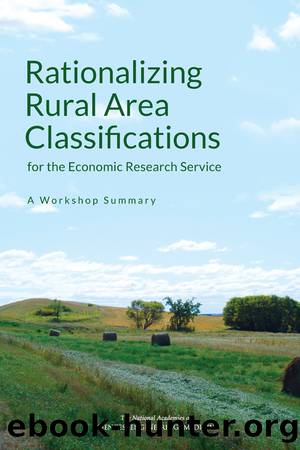Rationalizing Rural Area Classifications for the Economic Research Service: A Workshop Summary by Gooloo S. Wunderlich

Author:Gooloo S. Wunderlich
Language: eng
Format: epub
Publisher: The National Academies Press
Published: 2016-01-14T00:00:00+00:00
7
Changes in Social Science Data and Methods
This chapter summarizes the seventh session of the workshop, which addressed changes in social science data and methods and their impact on rural classification. Alan Murray (Drexel University) prepared a commissioned paper, Evolving Spatial Analytics and Rural Area Classification, for the workshop.
He summarized changing analytical possibilities, including Geographic Information System and spatial statistics, and increasingly powerful computing and advancement of technology. Sarah Low (Economic Research Service [ERS]) also described changing analytical possibilities, Richelle Winkler (Michigan Technological University) spoke about the availability and quality of data from the American Community Survey (ACS), and Michael Ratcliffe (Census Bureau) discussed more frequent availability of local-level data at lower levels of geographic scale. James Fitzsimmons was the moderator for this session.
STATEMENT BY ALAN MURRAY1
Murray stated that rural or rurality is a vague concept, but context and the purpose of the study matter. He pointed out there are many different perspectives and rationales motivating why analysts look at rurality and what that means for people in rural areas. For example, air service subsidies for rural airports define rural in a very different way than has been discussed at this workshop.
Categories of Data Sources
Murray said that there are more sources of data than from the U.S. Census Bureau. Some are government agency generated, including national and local. National products, in addition to those from the Census Bureau, include those from ERS, other U.S. Department of Agriculture agencies, and others. Local products encompass parcel and structure-oriented data. Private vendors may also scrape various sources. For example, he noted, the National Establishment Time-Series is scraped from Dun and Bradstreet. Private vendors may take published data, perhaps from the Internet, and make it available in a digital source. Geolibraries and geoportals include the U.S. General Services Administrationâs data.gov, as well as volunteer geographic information user-generated products such as Wikimapia, Openstreet, and others. Data are available from sensing platforms such as GPS, satellite imagery, aircraft, drones, and red-light cameras/videos. Sensing platforms include Google Street View in Google Maps, as well as cameras and traffic counters. User-generated sources include volunteer geographic information (VGI), where people add information that has a spatial orientation. There is also unintentional user-generated information, he noted. If a GPS is turned on in a personâs phone, it is tracking where the person is going. The person is generating data, but may not realize it. At Drexel, clothes are made with embedded radio frequency identification devices (RFID). The wearers do not realize they are generating data about their activities, body temperature, and bio-characteristics.
It is useful, he said, to think about how these varied sources might be used to derive characteristics of rural areas, although some of the sources, such as VGI, may have issues related to data quality. That can be problematic in various ways, Murray said.
Spatial Analytics
Murray defined spatial analytics as any of the quantitative methods to support analysis, policy, planning, and management involving geographic space. They support the systematic analysis of geographic data and are similar to and consistent with definitions of quantitative geography and geocomputation.
Download
This site does not store any files on its server. We only index and link to content provided by other sites. Please contact the content providers to delete copyright contents if any and email us, we'll remove relevant links or contents immediately.
Whiskies Galore by Ian Buxton(41880)
Introduction to Aircraft Design (Cambridge Aerospace Series) by John P. Fielding(33064)
Rewire Your Anxious Brain by Catherine M. Pittman(18553)
Craft Beer for the Homebrewer by Michael Agnew(18140)
Cat's cradle by Kurt Vonnegut(15186)
Sapiens: A Brief History of Humankind by Yuval Noah Harari(14252)
Leonardo da Vinci by Walter Isaacson(13184)
The Tidewater Tales by John Barth(12608)
Thinking, Fast and Slow by Kahneman Daniel(12079)
Underground: A Human History of the Worlds Beneath Our Feet by Will Hunt(12024)
The Radium Girls by Kate Moore(11921)
The Art of Thinking Clearly by Rolf Dobelli(10223)
A Journey Through Charms and Defence Against the Dark Arts (Harry Potter: A Journey Throughâ¦) by Pottermore Publishing(9232)
Mindhunter: Inside the FBI's Elite Serial Crime Unit by John E. Douglas & Mark Olshaker(9201)
Tools of Titans by Timothy Ferriss(8218)
Wonder by R. J. Palacio(8010)
Turbulence by E. J. Noyes(7936)
Change Your Questions, Change Your Life by Marilee Adams(7635)
Nudge - Improving Decisions about Health, Wealth, and Happiness by Thaler Sunstein(7615)
